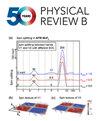Coexistence of charge density wave and field-tuned magnetic states in TmNiC2
IF 3.7
2区 物理与天体物理
Q1 Physics and Astronomy
引用次数: 0
Abstract
Exploring the relations between coexisting, cooperative, or competing types of ordering is a key to identify and harness the mechanisms governing the mutual interactions between them and to utilize their combined properties. We have experimentally explored the response of the charge density wave (CDW) to various antiferromagnetic, metamagnetic, and field-aligned ferromagnetic states that constitute the magnetic phase diagram of TmNiC2. The high-resolution x-ray diffraction experiment employing synchrotron radiation at low temperature and high magnetic field allowed one to follow the superstructure satellite reflections, being a sensitive probe of CDW. This investigation not only reveals direct evidence that the charge density wave avoids even a partial suppression in the antiferromagnetic ground state, but also proves that this state coexists, without any visible signatures of weakening, in the entire dome of the magnetically ordered phases, including the field-aligned ferromagnetic state. The calculations of the electronic and phonon structures support the experiment, revealing that the dominant contribution to the CDW transition stems from momentum-dependent electron-phonon coupling. We conclude that this mechanism prevents the CDW from vanishing, although the nesting conditions within the magnetically ordered phases deteriorate.TmNiC2中电荷密度波与场调谐磁态的共存
探索共存、合作或竞争类型排序之间的关系是识别和利用控制它们之间相互作用的机制并利用它们的组合属性的关键。我们通过实验探索了电荷密度波(CDW)对构成TmNiC2磁相图的各种反铁磁、超磁和场向铁磁态的响应。采用低温高磁场同步辐射的高分辨率x射线衍射实验,可以跟踪上层建筑卫星反射,是CDW的灵敏探针。这项研究不仅揭示了电荷密度波在反铁磁基态中甚至避免了部分抑制的直接证据,而且还证明了该状态在整个磁有序相(包括场向铁磁态)中共存,没有任何明显的减弱迹象。电子和声子结构的计算支持了实验,揭示了CDW跃迁的主要贡献来自动量依赖的电子-声子耦合。我们得出结论,这种机制可以防止CDW消失,尽管磁性有序相内的嵌套条件恶化。2025年由美国物理学会出版
本文章由计算机程序翻译,如有差异,请以英文原文为准。
求助全文
约1分钟内获得全文
求助全文
来源期刊

Physical Review B
物理-物理:凝聚态物理
CiteScore
6.70
自引率
32.40%
发文量
0
审稿时长
3.0 months
期刊介绍:
Physical Review B (PRB) is the world’s largest dedicated physics journal, publishing approximately 100 new, high-quality papers each week. The most highly cited journal in condensed matter physics, PRB provides outstanding depth and breadth of coverage, combined with unrivaled context and background for ongoing research by scientists worldwide.
PRB covers the full range of condensed matter, materials physics, and related subfields, including:
-Structure and phase transitions
-Ferroelectrics and multiferroics
-Disordered systems and alloys
-Magnetism
-Superconductivity
-Electronic structure, photonics, and metamaterials
-Semiconductors and mesoscopic systems
-Surfaces, nanoscience, and two-dimensional materials
-Topological states of matter
 求助内容:
求助内容: 应助结果提醒方式:
应助结果提醒方式:


